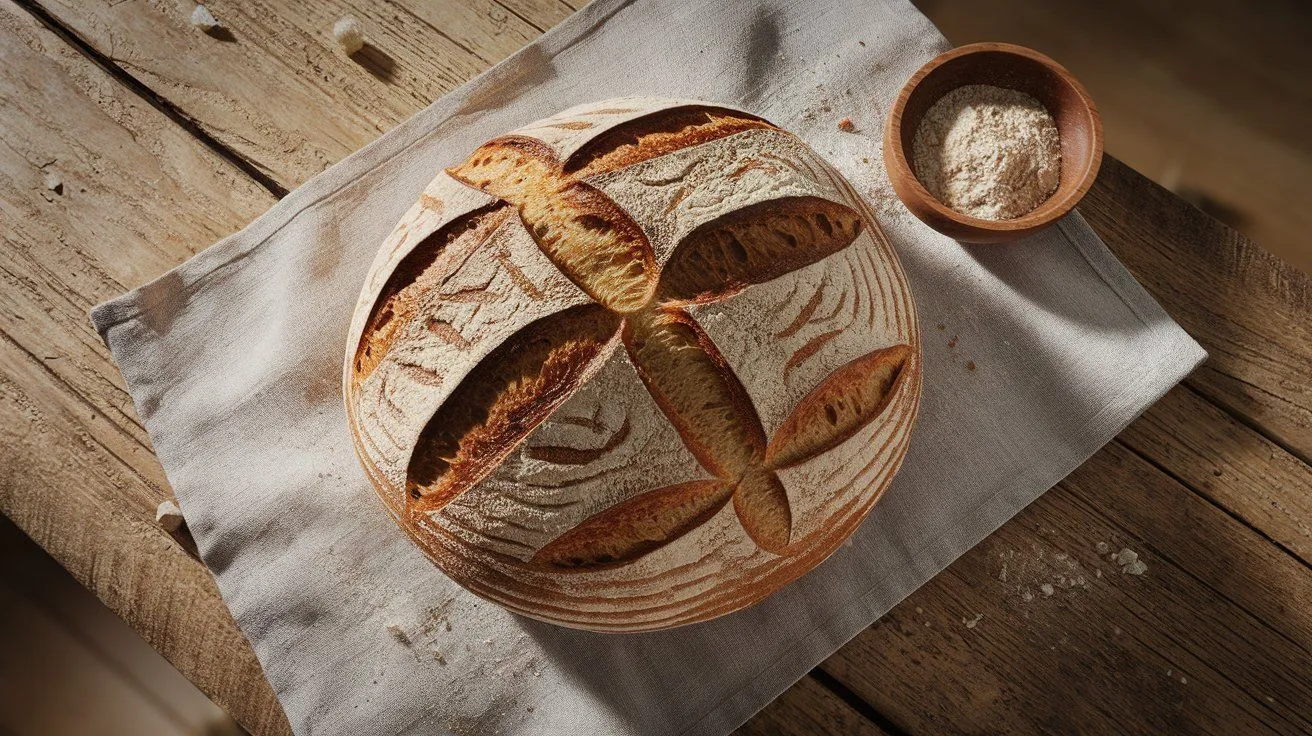Table of Contents
There’s something magical about the smell of freshly baked bread wafting through the kitchen, and when that bread is made with Einkorn, the joy is taken to a whole new level. Einkorn Sourdough Bread Recipe isn’t just any bread, it’s an ancient grain that brings a rich, nutty flavor with a chewy, rustic crust that makes each bite feel like a warm hug.
Whether you’re baking it to enjoy with your family or to savor as a personal treat, this bread brings a little bit of comfort and a lot of heart. The best part? You don’t need to be an expert baker to pull this off, even first-timers can create a delicious loaf with just a little patience and the right guidance. Readyready to enjoy the simple pleasure of making a nourishing loaf that feels as good as it tastes? Let’s dive in.
What Is Einkorn Sourdough Bread?
Einkorn Sourdough Bread is made with Einkorn, one of the oldest grains in the world. This ancient wheat brings a nutty, rich flavor and a slightly denser texture compared to regular sourdough. The unique sourdough fermentation process gives it a tangy, delightful taste while providing a chewy, rustic crust.Each bite offers a warm connection to the past, rich with natural flavor and old-world charm.
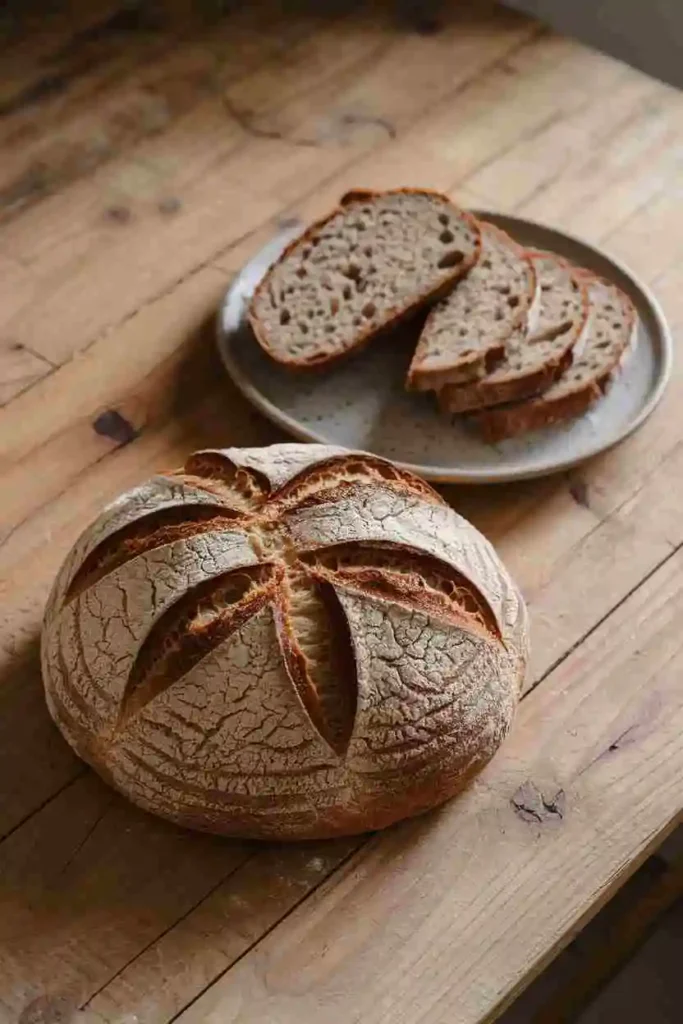
Why You’ll Love This Recipe
Rich, Nutty Flavor:
Einkorn has a naturally warm taste that gives your bread a deeper, more earthy character than regular sourdough.
Great Texture Every Time:
Expect a crisp golden crust with a soft, slightly springy center, ideal for slicing, toasting, or tearing warm from the oven.
Beginner-Friendly:
This recipe walks you through each step clearly, making it a smooth start if you’re new to baking with ancient grains.
Genuinely Rewarding:
There’s something about baking your own loaf that hits differently. It’s cozy, satisfying, and makes a thoughtful homemade gift.
Essential Ingredients for the Recipe
Einkorn Flour: This ancient grain is the star of the show, bringing a rich, nutty flavor that you won’t find in regular wheat flour.
Sourdough Starter: This will help your bread rise and develop that signature tangy flavor.
Water: Plays a key role in bringing the dough together and waking up your sourdough starter so it can do its job.
Salt: A pinch of salt enhances the flavor and helps balance the bread’s natural sweetness.
Optional Sweetener: (Honey or Sugar): A tiny bit of honey or sugar can help feed the yeast and promote a better rise, although it’s optional.
These ingredients are all you need to create a mouthwatering loaf of Einkorn Sourdough Bread that’s both comforting and wholesome.
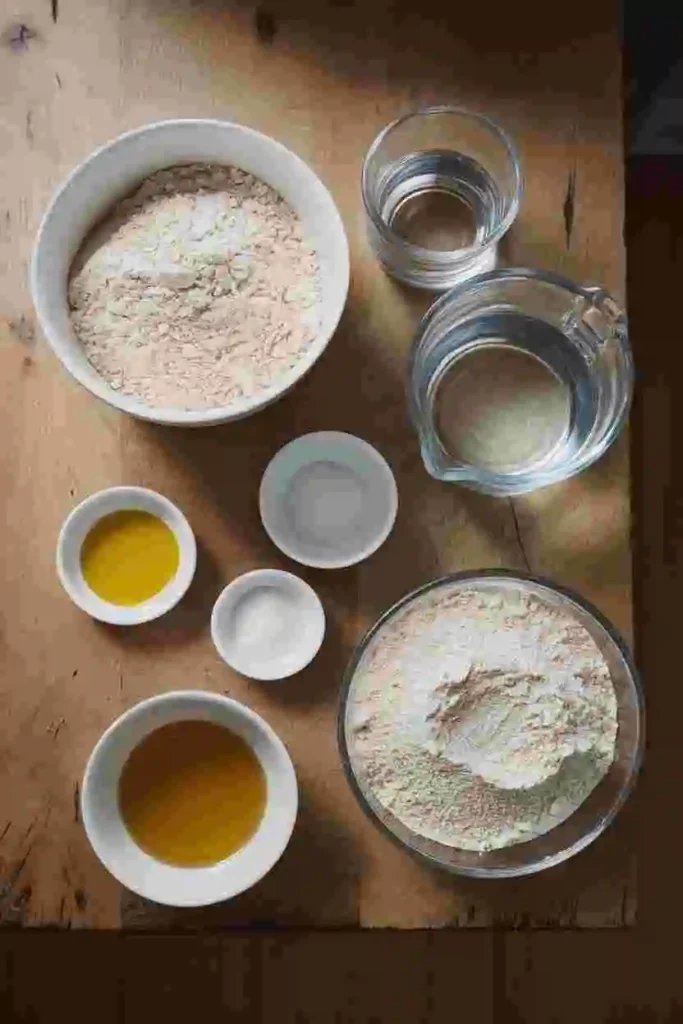
Tools You’ll Need
Mixing Bowls: A large bowl for combining ingredients, and a smaller one for your sourdough starter.
Dough Scraper: Ideal for shaping and transferring dough, ensuring a clean and effortless transfer.
Dutch Oven or Baking Stone: These tools are key to achieving that beautifully crisp, golden-brown crust that makes sourdough irresistible.
Kitchen Scale: Accurate measurements are crucial, especially for flour and water. A scale ensures consistency and precision in your bread-making.
Bread Knife: Perfect for dividing and shaping your dough, ensuring you get those even portions and perfect loaves every time.
Tips for a Perfect Rise and Crust
1. Create a Warm Rising Environment
Einkorn dough prefers a cozy space to rise. Aim for a temperature around 75°F (24°C). If your kitchen tends to be cooler, try placing the bowl inside the oven with the light on, it provides gentle, consistent warmth without overheating.
2. Handle with Care
Since Einkorn contains a unique form of gluten that doesn’t respond like regular wheat, there’s no need for intense kneading, gentle handling works best. A light touch keeps the dough soft and helps maintain an open, tender crumb. Trust the process and allow the dough to rest rather than forcing it.
3. Use Moisture to Your Advantage
Baking with steam is a game-changer for crust development. Use a Dutch oven with a lid to lock in steam for the first part of baking, this helps the loaf rise higher and form a crisp, golden shell.
4. Slash with Precision
Scoring the dough isn’t just for looks, it guides how your bread expands in the oven. Just before baking, take a sharp knife or bread lame and gently score the surface with clean, deliberate slashes to help the loaf expand in the oven.
5. Let the Loaf Cool Fully
Hold off on cutting into the loaf immediately after baking, it needs time to settle for the best texture and flavor. Let the bread rest on a cooling rack until it has fully cooled down, giving it time to set and develop its final texture. This resting time helps the interior set properly and deepens the flavor.
Common Mistakes to Avoid
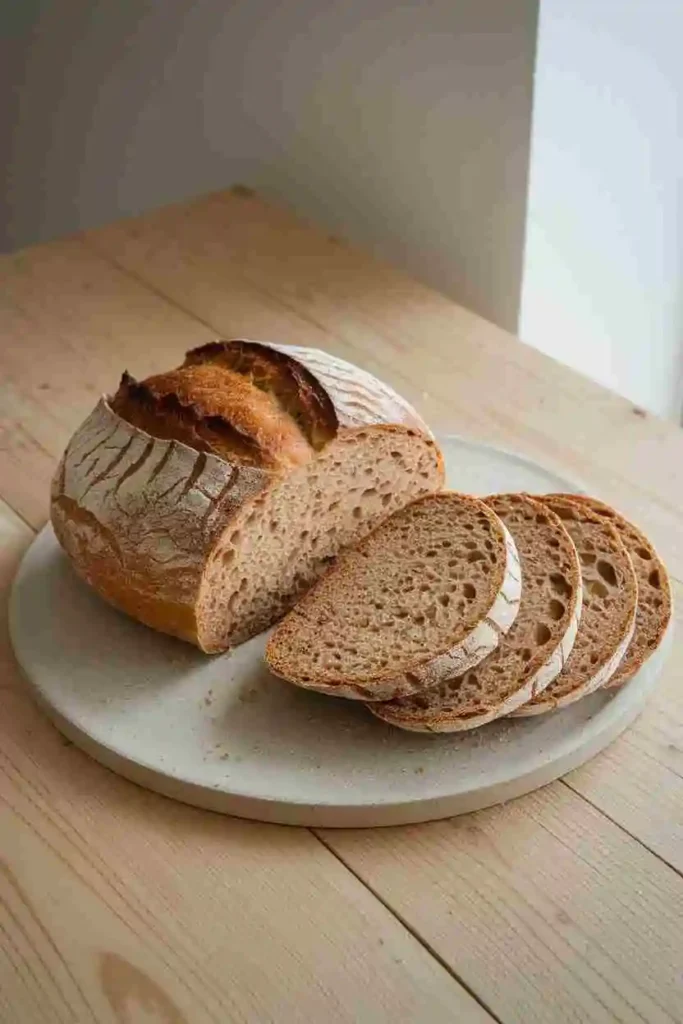
Skipping the Scale
Eyeballing your flour and water can lead to a dough that’s too dry or too wet. Always weigh your ingredients for better results.
Too Much Kneading
Einkorn doesn’t need much mixing. Overworking the dough can lead to a dense texture instead of that soft, open crumb.
Not Letting It Cool
Slicing the bread too early can leave the center overly moist or doughy. Let it sit for at least an hour so the interior can firm up properly and the flavors can fully develop.
Serving Suggestions
Classic and Simple:
Slice it thick and spread with real butter or a drizzle of olive oil and flaky sea salt.
Breakfast Favorite:
Toast a slice and top it with smashed avocado, a squeeze of lemon, and a sprinkle of chili flakes.
For Sandwiches:
Use it for grilled cheese or turkey sandwiches—it holds up beautifully without falling apart.
Soup’s Best Friend:
Pair it with creamy tomato soup or a hearty stew. Its crusty edges soak up just the right amount without going soggy.
How to Store Einkorn Sourdough Bread
For 1–2 Days:
Set the loaf with the cut side facing down on a wooden board, or gently wrap it in a fresh cotton or linen cloth. This method helps maintain the crust’s crispness while preventing the interior from drying out.
For Up to 4–5 Days:
Store your bread in a container that promotes airflow, such as a paper bag or bread box, and keep it at room temperature. Steer clear of plastic bags, as they can trap moisture, causing the crust to soften or mold to form.
For Longer Storage:
Cut the bread into slices and insert parchment paper between each piece to keep them from sticking together. Store the sliced bread in a bag or container that’s safe for freezing. When ready to enjoy, toast the slices directly from the freezer or warm them in the oven to revive their freshness.
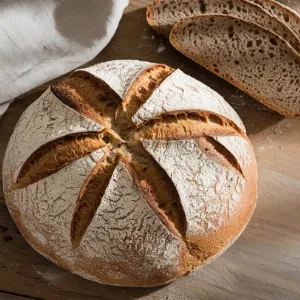
Einkorn Sourdough Bread Recipe
Ingredients
- 360 g all-purpose einkorn flour
- 120 g whole grain einkorn flour or simply use more of the all-purpose if you don’t have whole grain on hand
- 300 ml filtered water at room temperature not cold, not hot – just comfortable
- 240 g bubbly sourdough starter made with einkorn flour
- 8 g sea salt fine or medium grain works best
Optional Add-ins:
- 1 tablespoon olive oil
- 1 teaspoon honey
Instructions
- Prepare the Sourdough Starter: If you're using a pre-made or chilled sourdough starter, refresh it by mixing in the same amount of whole grain Einkorn flour and clean, filtered water to bring it back to life. Let it sit at room temperature until it becomes active and bubbly, typically within 4 to 8 hours.
- Combine the Ingredients: In a large mixing bowl, stir the active starter into the filtered water until dissolved. Begin blending in the Einkorn flour and salt a little at a time, mixing until the dough becomes thick, uneven, and slightly tacky to the touch. Einkorn flour tends to produce a wetter dough compared to standard wheat, which is normal.
- Rest and Stretch: Let the dough relax for 15–30 minutes. Then, using damp hands, stretch one side of the dough and fold it toward the center. Gently fold the edges of the dough towards the center, then cover the bowl and let it sit for an additional 20 to 30 minutes.
- Strengthen the Dough: Continue stretching and folding the dough two additional times, letting it sit and relax for about half an hour between each round to build structure. This process gently builds structure in the dough without overworking it, ideal for the delicate nature of Einkorn gluten.
- First Rise (Bulk Fermentation): Cover the dough and allow it to rise in a warm spot until it has expanded noticeably, usually about 4 to 6 hours. The timing may vary depending on the room temperature.
- Shape the Dough: Dust a clean surface with flour and gently transfer the dough onto it. Press it gently to release large air bubbles, then shape it into a round or oval loaf.Place the dough into a proofing basket dusted with flour, or a bowl lined with a generously floured cloth.
- Refrigerate Overnight: Cover the shaped dough and place it in the refrigerator to ferment slowly overnight. This long, cold proof deepens the flavor and makes the dough easier to handle during baking.
- Bake the Loaf: The following day, heat your oven to 450°F (230°C), placing a Dutch oven or baking stone inside to warm up. Once the dough has chilled to the right temperature, remove it from the fridge and set it on a piece of parchment paper. With a sharp blade, make shallow cuts on the top, then gently transfer the dough into the preheated Dutch oven.Place the lid on the dough and bake it for 25 to 30 minutes to allow it to cook through. After that, take off the lid and continue baking for another 15 to 20 minutes, or until the bread’s crust is beautifully golden and crisp.
- Cool Before Slicing: After baking, gently remove the loaf from the hot oven and place it on a wire rack so it can cool off naturally without getting soggy underneath. Give it plenty of time to cool so the texture settles and the flavors can fully develop. Slicing before it's fully cooled can alter its texture and moisture, while cooling helps enhance the flavor.
Notes
- Calories: 202
- Fat: 1g
- Carbohydrates: 38g
- Protein: 5g
- Fiber: 2g
- Sugar: 0g
- Sodium: 190mg
FAQs
Why is my Einkorn sourdough bread so dense?
Einkorn has a weaker gluten structure, so it doesn’t rise as high as modern wheat breads. Make sure your dough is well-hydrated, fully fermented, and not over-handled.
What flour do Italians use for sourdough?
Italian bakers often use Type 1 or Type 2 flour, which is similar to whole grain flour. For a rustic feel, you can mix einkorn with spelt or whole wheat.
What is the best mix of flours for sourdough?
A balanced blend could be einkorn with a bit of whole wheat or rye. This adds depth and improves structure while keeping the mild flavor of einkorn.
Do I need yeast for sourdough bread?
No extra yeast is needed. Sourdough relies on natural wild yeast from your starter, which develops flavor and helps the dough rise.
Is Einkorn sourdough better than regular sourdough?
“Better” depends on your taste. Einkorn has a naturally sweet, nutty flavor and a softer crumb, which many find more enjoyable.
Why is my Einkorn sourdough starter not rising?
It may need a few more days to build strength. Keep feeding it regularly in a warm spot, and make sure you’re using clean tools and filtered water.
How to strengthen a sourdough starter?
Feed it at regular times daily, use whole grain flour like rye or whole wheat, and keep it at room temperature until it becomes active and bubbly.
How long to bulk ferment Einkorn sourdough?
Einkorn ferments faster than other flours. Keep an eye on the dough, it’s usually ready in 3 to 5 hours, depending on room temperature.

